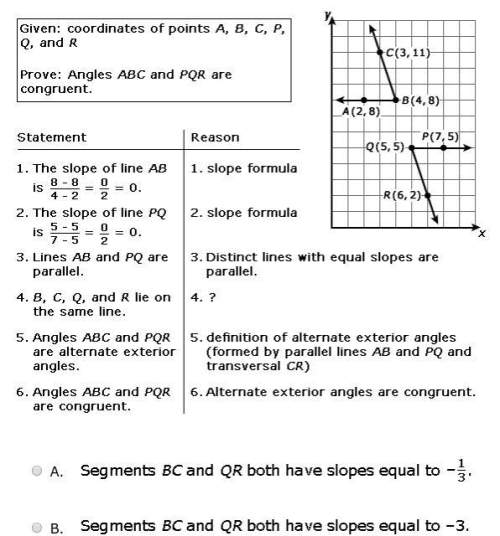
Mathematics, 20.10.2020 18:01, cxttiemsp021
An online furniture store sells chairs for $100 each and tables for $400 each. The store must sell no less than $5400 worth of chairs and
tables each day. Write an inequality that could represent the possible values for the number of tables sold, t, and the number of chairs
sold, c, that would satisfy the constraint.
O A. 1000+4000 5400
OB. 1000+400ts 5400
O C. 1000+400t> 5400
O D. 1000+400t<5400

Answers: 1
Other questions on the subject: Mathematics

Mathematics, 21.06.2019 19:40, love0000
Atextile fiber manufacturer is investigating a new drapery yarn, which the company claims has a mean thread elongation of 12 kilograms with a standard deviation of 0.5 kilograms. the company wishes to test the hypothesis upper h subscript 0 baseline colon mu equals 12 against upper h subscript 1 baseline colon mu less-than 12 using a random sample of n equals 4 specimens. calculate the p-value if the observed statistic is x overbar equals 11.8. round your final answer to five decimal places (e. g. 98.76543).
Answers: 3

Mathematics, 21.06.2019 22:00, haleysmith8608
In dire need~! describe how to use area models to find the quotient 2/3 divided by 1/5. check your work by also finding the quotient 2/3 divided by 1/5 using numerical operations only.
Answers: 1

Mathematics, 21.06.2019 22:40, michaellagann2020
Adeli owner keeps track of the to-go orders each day. the results from last saturday are shown in the given two-way frequency table. saturday's to-go deli orders in person by phone online total pick up 38 25 31 94 delivery 35 28 34 97 total 73 53 65 191 what percent of the to-go orders were delivery orders placed by phone? a. 14.66% b. 38.41% c. 28.87% d. 52.83%
Answers: 2

Mathematics, 21.06.2019 23:00, kj44
Each of the following data sets has a mean of x = 10. (i) 8 9 10 11 12 (ii) 7 9 10 11 13 (iii) 7 8 10 12 13 (a) without doing any computations, order the data sets according to increasing value of standard deviations. (i), (iii), (ii) (ii), (i), (iii) (iii), (i), (ii) (iii), (ii), (i) (i), (ii), (iii) (ii), (iii), (i) (b) why do you expect the difference in standard deviations between data sets (i) and (ii) to be greater than the difference in standard deviations between data sets (ii) and (iii)? hint: consider how much the data in the respective sets differ from the mean. the data change between data sets (i) and (ii) increased the squared difference îł(x - x)2 by more than data sets (ii) and (iii). the data change between data sets (ii) and (iii) increased the squared difference îł(x - x)2 by more than data sets (i) and (ii). the data change between data sets (i) and (ii) decreased the squared difference îł(x - x)2 by more than data sets (ii) and (iii). none of the above
Answers: 2
Do you know the correct answer?
An online furniture store sells chairs for $100 each and tables for $400 each. The store must sell n...
Questions in other subjects:




Mathematics, 26.08.2019 06:10

History, 26.08.2019 06:10



History, 26.08.2019 06:10

Mathematics, 26.08.2019 06:10

Mathematics, 26.08.2019 06:10







